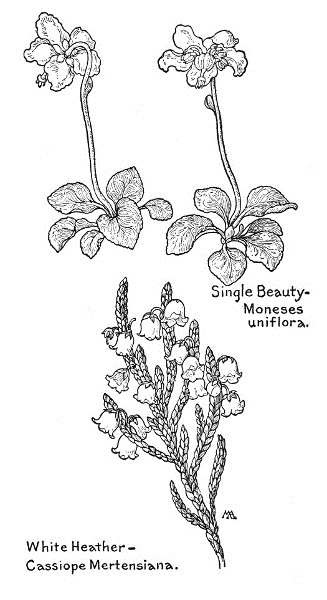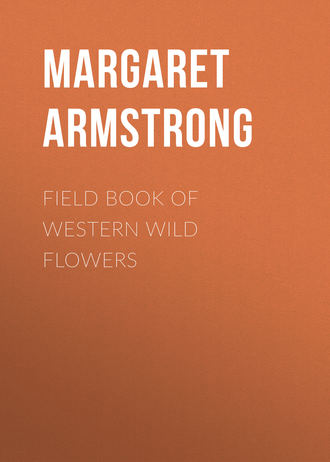 полная версия
полная версияПолная версия
Field Book of Western Wild Flowers
Decorative in form and color and unusual looking, with smooth, pale bluish-green foliage, with a "bloom," the leaves prettily cut and lobed, with pinkish leafstalks, forming, when young, a large rosette, close to the ground, but the stem gradually lengthens until the cluster of leaves, after the flowers are gone, finds itself on the summit of a long stem, sheathed at base. The minute, bright yellow flowers form flat-topped clusters, with flower-stems two or three inches tall, not hollow, the main cluster about an inch across, usually without bracts, and composed of five to ten smaller clusters, with bracts. When the plant is young the general effect of the flat, pale gray rosette of fern-like leaves, spotted with the contrasting yellow of the flowers, is pretty and striking. Sometimes a few of the flowers are purple. This has a thick root and grows on dry sunny hills, in gravelly soil.

Velaea arguta.
Eulophus Bolanderi.
Purple Sanicle – Sanicula bipinnatifida.
DOGWOOD FAMILY. Cornaceae
Not a very large family, most abundant in the northern hemisphere, mostly trees or shrubs. They have simple, mostly toothless leaves, without stipules, usually opposite or in whorls. The flowers are in round or flat-topped clusters and have four or five sepals and petals and four to many stamens. The inferior ovary becomes a stone-fruit that looks like a berry. Cornus is from the Greek for "horn," in allusion to the toughness of the wood.
There are many kinds of Cornus, some natives of Mexico and Peru, with small, white, greenish or purple flowers, in clusters, which often have an involucre of large, white bracts.
Pacific Dogwood
Córnus Nuttállii
White
Spring, summer
Oreg., Wash., Cal.
A handsome shrub or small tree, from ten to thirty feet high and growing in rich woods, often near streams. The flower clusters are composed of numerous, small, greenish flowers, forming a large, protruding knob, which is surrounded by large, white, petal-like bracts, usually six in number, giving the effect of a single handsome flower, measuring from three to six inches across. It resembles the Flowering Dogwood of the East, but as the flowers have six instead of four "petals," the tips of which in Yosemite are neither puckered nor stained with pink, they look different to eastern eyes and the general appearance, though equally fine, is less picturesque, probably because the shrub is rather larger and less straggling, the flowers bigger and more symmetrical, and the leaves brighter green. The effect of the flat masses of creamy white bloom among the darker forest trees is magnificent, and in Washington and Oregon the leaves turn to brilliant red in the autumn. The fruit is a cluster of bright red berries. The wood is exceedingly hard and is used in cabinet-making. There is a tradition that when Dogwood blooms corn should be planted.

Pacific Dogwood – Cornus Nuttallii.
Red-osier Dogwood
Córnus stolonífera var. ripària
White
Spring, summer, autumn
Utah, Ariz., New Mex., Col.
A handsome shrub, five to eight feet high, with smooth, dark red branches and bright red twigs. The leaves are thin in texture, smooth and rich-green on the upper side, paler on the under, and the small, cream-white flowers, with long, yellow stamens, form handsome, flat-topped clusters, about two inches across, smelling pleasantly of honey; the berries are dull white. This is common.
Bunchberry
Córnus Canadénsis
White
Summer
West, except Ariz.
A charming little plant, about six inches high, growing in moist, cool woods and common in the East. The slender stem, with one or two pairs of small leaves, springs from creeping, woody shoots and is crowned by a circle of larger leaves, six, or rarely four, in number, smooth and bright green, setting off a pretty white blossom, with a slender flower-stalk. This looks like a single flower, measuring about an inch across, but it is really composed of a number of tiny, greenish flowers, forming a cluster in the center, and surrounded by four white bracts, which look like large petals. The flowers are succeeded by a bunch of red berries, insipid in flavor, but vivid scarlet in hue.
HEATH FAMILY. Ericaceae
A large and interesting family, of very wide geographic distribution, in temperate and cold regions; herbs, shrubs, or trees; the leaves undivided, without stipules; the flowers mostly perfect; the calyx with four or five divisions; the corolla usually regular, with four or five, usually united, petals; the stamens inserted under the pistil, usually as many, or twice as many, as the petals; the ovary usually superior, with one style; the fruit a capsule, berry, or stone-fruit, usually with many small seeds.
There are many kinds of Gaultheria, mostly of the Andes; ours are evergreen shrubs, with alternate, aromatic leaves and nodding flowers; the calyx five-cleft; the corolla more or less urn-shaped, with five teeth; the stamens ten; the fruit a berry, composed of the fleshy calyx surrounding the ovary and containing many seeds. The Wintergreen, or Checkerberry, used for flavoring, belongs to this genus.
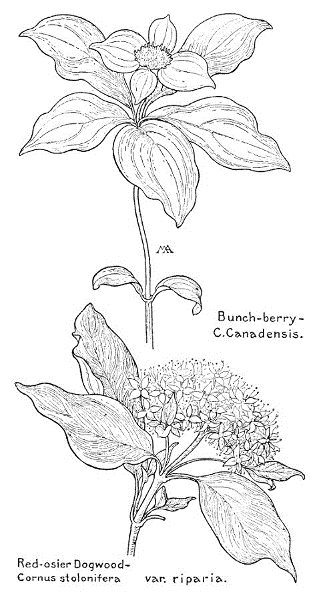
Bunch-berry – C. Canadensis.
Red-osier Dogwood – Cornus stolonifera var. riparia.
Western Wintergreen
Gaulthèria ovatifòlia
White
Summer
Northwest
A pretty little shrub, growing in mountain woods, a few inches high, with woody stems, spreading on the ground, and glossy foliage, almost hiding the flowers. The twigs are fuzzy and the leaves are dark rich-green, the small flowers white and the berries red.
Salal, Shallon
Gaulthèria Shállon
White, pink
Spring, summer
Northwest
An attractive little shrub, usually from one to three feet high, with handsome foliage. The leaves are finely toothed, dark olive-green, leathery and rather glossy, pale on the under side, and the waxy flowers hang gracefully on a stiffly bending flower-stem, which is sticky and hairy and often bright red, with large, scaly, red bracts at the base of the pedicels and smaller bracts halfway up. The flowers are nearly half an inch long, with a yellowish calyx, covered with reddish hairs, and a white corolla, tipped with pink, or all pink; the filaments hairy, with orange anthers. There is often so much bright pinkish-red about the flower-stems and bracts that the effect, with the waxy flowers and dark foliage, is very pretty. This plant often grows in great quantities, thickly covering the floor of the redwood forests. It is called Salál by the Oregon Indians, who value the black, aromatic berries as an important article of food.
There are many kinds of Azalea, of North America and Asia, mostly tall, branching shrubs; leaves alternate, thin, deciduous; flowers large, in terminal clusters, developing from cone-like, scaly buds; calyx small, five-parted; corolla funnel-form, five-lobed or somewhat two-lipped; stamens five, rarely ten, protruding, usually drooping; style long, slender, drooping; capsule more or less oblong.
Western Azalea
Azàlea occidentàlis (Rhododendron)
White
SummerCal., Oreg.
One of the most beautiful western shrubs, from two to ten feet high, loosely branching, with splendid clusters of flowers and rich-green leaves, almost smooth, from one to four inches long, with a small, sharp tip and clustered at the ends of the twigs. The corolla is from one and a half to three inches long, slightly irregular, white with a broad stripe of warm-yellow on the upper petal and often all the petals striped with pink. The western woodland streams are bordered with these wonderful blossoms, leaning over the water and filling the air with their delicious fragrance.
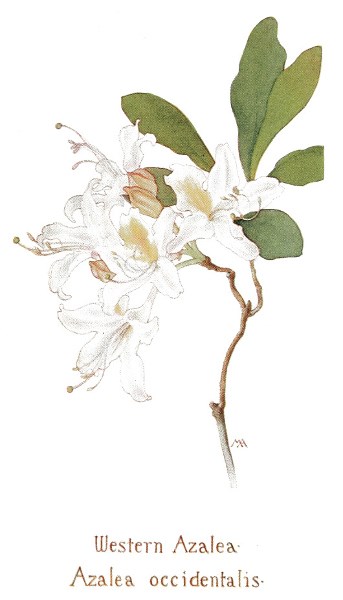
Western Azalea – Azalea occidentalis.
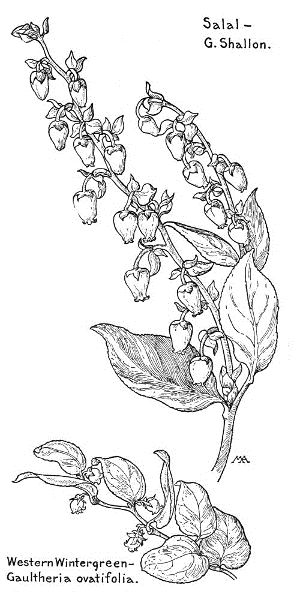
Salal – G. Shallon.
Western Wintergreen – Gaultheria ovatifolia.
There are many kinds of Rhododendron, most abundant in Asia, resembling Azalea, but with evergreen, leathery leaves. The name is from the Greek, meaning "rose-tree."
California Rose Bay
Rhododéndron Califórnicum
Pink
Spring, summer
Northwest
A magnificent shrub, the handsomest in the West, from three to fifteen feet high, with a grayish trunk and fine, evergreen foliage. The leaves are from three to ten inches long, rich-green and leathery, smooth but not shiny, paler on the under side, spreading out around the large flower-clusters, so as to set them off to great advantage, and the flowers are over two inches across, scentless, with small, pale sepals and pink corollas, almost white at the base and shading to deep pink at the edges, which are prettily ruffled. The upper petal is freckled with golden-brown, or greenish spots and arrow-shaped markings, the pistil is crimson and the stamens, with pale pink filaments and pale yellow anthers, curve in, like little serpents' heads. The coloring of the flower clusters, mixed with the crimson-tipped buds, is a combination of delicate and brilliant tints and in such places as the redwood forests, along the Noyo River in California, where the shrub develops into a small tree, the huge clusters, glowing high above us among the dark forest trees, are a wonderful sight. This is the "State flower" of Washington.
There are a good many kinds of Arctostaphylos, mostly western; evergreen shrubs, with very crooked branches; smooth, dark red or brown bark; alternate leaves, and usually nodding, white or pink flowers, with bracted pedicels, in terminal clusters, the parts usually in fives; the corolla urn-shaped; the stamens usually ten, not protruding, the filaments hairy; the ovary raised on a disk on the receptacle; the fruit berry-like, several nutlets surrounded by soft pulp. The leaves, by a twisting of their stalks, assume a vertical position on the branches, a habit which enables many plants of dry regions to avoid unnecessary evaporation. These shrubs are often very abundant and with Chaparral Pea, Buck Brush, Scrub Oak, etc., form the extensive brush thickets known as chaparral, so characteristic of the western mountain scenery. The Greek name means "bear-berry," as bears are fond of the berries, and Manzanita is from the Spanish for "little apple," as the fruits often resemble tiny apples. They are dry but pleasantly acid and are popular with Indians, bears, and chipmunks, and jelly can be made from them. The largest Manzanita tree known is one in Napa County, California, thirty-five feet high and as large across.
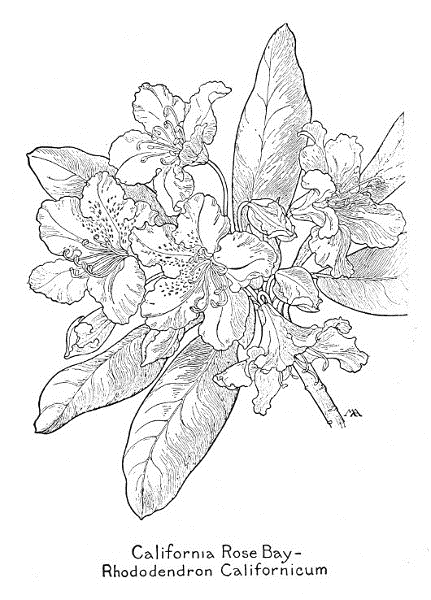
California Rose Bay – Rhododendron Californicum.
Green Manzanita
Arctostáphylos pátula
Pink
Winter, spring
California
A decorative shrub, from four to six feet high, with spreading branches. The leaves are from one to two inches long, smooth, pale green, and leathery and the flowers are waxy, a quarter of an inch or more long, crowded in pretty, roundish clusters, of various shades of pink. The very smooth trunk and branches are picturesquely gnarled and twisted and, in fine contrast to the pale foliage, are rich mahogany-color, with here and there openings in the outer bark, showing the gray, under layer, as if the branches had been dipped in hot chocolate, which had melted off in some places. The berry is about a quarter of an inch across, smooth and fleshy. This forms most of the chaparral on the slopes around the Yosemite Valley, ranging from over four thousand to nine thousand feet in altitude, and is widely distributed in the Sierra Nevada Mountains.
Manzanita
Arctostáphylos bícolor
Pink
Spring
California
A handsome shrub, three or four feet high, with rich-green leaves, very glossy on the upper side and covered with close white down on the under. The waxy flowers are a lovely shade of pink and the pretty fruit is about the size of a pea, like a tiny greenish-yellow apple, with a brownish-red cheek. This grows in the South near the coast.
Kinnikinic.
Red Bearberry
Arctostáphylos Ùva-Úrsi
White
Spring, summer
West, etc.
An attractive little shrub, with many trailing branches, creeping over the ground and often covering the rocks with a beautiful mat of evergreen foliage. The leaves are small, toothless, shining and leathery and the little white or pinkish, bell-shaped flowers hang in pretty little clusters and are succeeded by smooth, round, red berries. This is common in the mountains, across the continent, reaching an altitude of ten thousand feet. The Indians use it medicinally and in the curing of animal skins. There is a picture of this in Schuyler Mathews' Field Book.
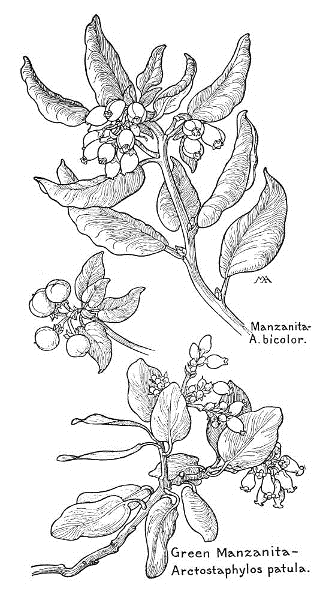
Manzanita – A. bicolor.
Green Manzanita – Arctostaphylos patula.
There are a great many kinds of Vaccinium, widely distributed; branching shrubs, with alternate leaves and small flowers, usually in clusters; the ovary inferior, the fruit a many-seeded berry, crowned with the remains of the calyx-teeth. This is the classic Latin name. These plants include Blueberry, Huckleberry, and Bilberry.
California Huckleberry
Vaccínium ovàtum
White, pink
Spring, summer
Cal., Oreg.
An attractive shrub, from four to eight feet high, with beautiful, glossy, evergreen foliage, which is very ornamental and much used in household decoration. The older leaves are rich dark green, contrasting finely with the younger, apple-green leaves and, in the spring, with the charming little red ones, with which the twigs are tipped. They are leathery in texture and very neatly arranged along the branches, which are ornamented with pretty clusters of waxy, white or pink flowers, a quarter of an inch long, or with purple berries, without a "bloom," which are edible and make excellent preserves. This grows on hills near the coast, especially among the redwoods.
There is one kind of Azaleastrum; resembling Rhododendron, but with deciduous leaves; and resembling Azalea, but the flowers developing from lateral instead of terminal buds, the corolla with five, regular lobes, and the stamens shorter.
Small Azalea
Azaleástrum albiflòrum (Rhododendron)
White
Summer
Northwest
An attractive shrub, from two to six feet high and loosely branching, with grayish-brown bark and rich-green leaves, glossy, but not stiff or leathery. The flowers are about an inch across, with a sticky, aromatic, pale green calyx and waxy-white corolla, the style and stamens pale yellow or white. They have no scent and are not so handsome as the last, but are very beautiful, growing in high mountains, often close to the snow line.
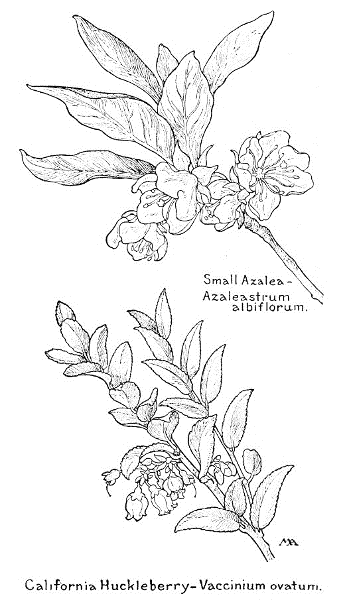
Small Azalea – Azaleastrum albiflorum.
California Huckleberry – Vaccinium ovatum.
There are several kinds of Kalmia, almost all of eastern North America, the flowers alike in form.
Swamp Laurel
Kálmia microphýlla (K. glauca var. microphylla)
Pink
Summer
Northwest, etc.
A very pretty little evergreen shrub, from a few inches to over a foot high, with glossy, leathery, rich-green leaves, whitish on the under side, with the margins rolled back. The flowers are single or in clusters, each about half an inch across, with five sepals and a bright purplish-pink, saucer-shaped corolla, with five lobes, which is prettily symmetrical and intricate in form. There are ten little pouches below the border and in these the tips of the ten anthers are caught, so that the filaments curve over from the center, and at the touch of a visiting insect they spring out of the pouches and dust the visitor's back with pollen, which is carried to another flower. The little, pointed buds, angled and deep in color, are also pretty and the capsule is roundish, with many small seeds. This grows in northern swamps, across the continent.
There are several kinds of Menziesia, some Japanese; branching shrubs, with alternate, deciduous, toothless leaves, and small, nodding flowers, in clusters, developing from scaly buds, their parts almost always in fours; stamens eight, not protruding; capsule more or less egg-shaped.
Fool's Huckleberry
Menzièsia urcelolària (M. ferruginea)
Yellowish, reddish
Summer
Northwest
A rather attractive little bush, from two to six feet high, with light brown bark, hairy twigs and slightly hairy leaves, with hairy margins. The flowers are less than half an inch long, with a hairy calyx and dull cream-colored corolla, tinged with dull-pink or red, and hang prettily in a circle, on drooping pedicels, which become erect as the capsules ripen. When crushed, the stems and foliage have a strong skunk-like smell.
There are only a few kinds of Ledum, all much alike.
Woolly Labrador Tea
Lèdum Groenlándicum
White
Spring, summer
Northwest, etc.
A loosely-branching, evergreen shrub, from one to four feet high. The bark is reddish and the twigs are covered with reddish wool, the color of iron rust, and the leathery, dark green leaves, which are alternate, with rolled-back margins, are also covered with reddish wool on the under side. The flowers are a good deal less than half an inch across, with five, very small sepals; five, spreading, white petals; a green ovary, and from five to seven, long, conspicuous stamens, giving a feathery appearance to the pretty flower-clusters, which before blooming are enclosed in large, scaly buds. Both foliage and flowers are aromatic. This is found across the continent, as far south as Pennsylvania, and in Greenland. L. glandulòsum is similar, but not woolly. These plants grow in swamps and damp places and are considered poisonous.
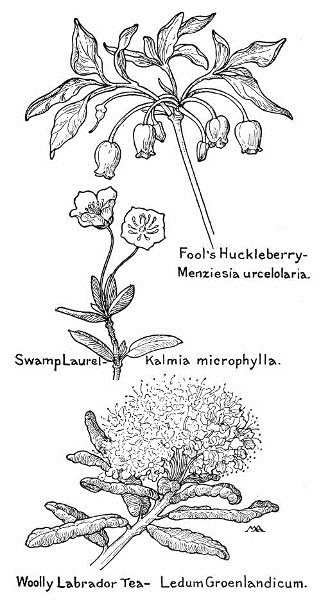
Fool's Huckleberry – Menziesia urcelolaria.
Swamp Laurel – Kalmia microphylla.
Woolly Labrador Tea – Ledum Groenlandicum.
There are only a few kinds of Phyllodoce, of arctic and alpine regions; low shrubs, with small, leathery, evergreen leaves; flowers nodding, with bracts, in terminal clusters; calyx usually with five divisions; corolla more or less bell-shaped, usually five-lobed; stamens usually ten; stigma with a round top, or four to six lobes; capsule roundish: often called Heather, but we have no native Heather.
Red Heather
Phyllódoce Bréweri (Bryanthus)
Pink
Summer
Northwest
A charming little shrub, from six to ten inches tall, with gay flowers and dark yellowish-green leaves, standing out stiffly from the stem, like the bristles of a bottle-brush. The flowers are sweet-scented, nearly half an inch across, with reddish calyxes and pedicels and bright pink, saucer-shaped corollas, with from seven to ten, long, purple stamens, a purple pistil and crimson buds. This makes heathery patches on high mountain slopes, up to twelve thousand feet in the Sierra Nevadas.
Red Heather
Phyllódoce empetrifórmis (Bryanthus)
Pink
Summer
Northwest
Much like the last, but the nodding flowers are smaller and not quite so pretty, with bell-shaped corollas and the stamens not protruding. It forms beautiful patches of bright purplish-pink color on mountainsides, up to eleven thousand feet, farther north than the last.
Yellow Heather
Phyllódoce glanduliflòra (Bryanthus)
Yellowish
Summer
Northwest
This makes heather-like patches on rocks and has many rough, woody stems, crowded with yellowish-green leaves, shorter and broader than those of Red Heather. The drooping flowers are about three-eighths of an inch long, with a hairy, greenish-yellow calyx and yellowish corolla, something between cream and pale-lemon in color. At a distance the effect of the flowers is much more yellow than close by, but they are not so pretty as either the red or white heathers.
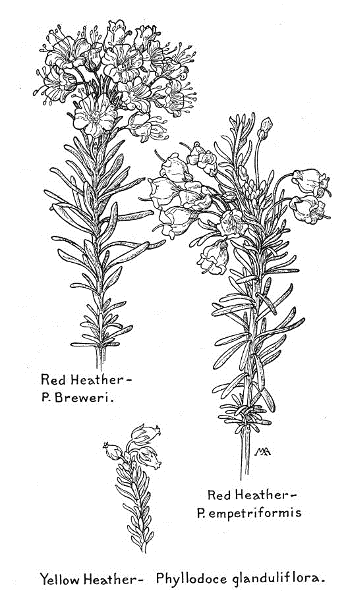
Red Heather – P. Breweri.
Red Heather – P. empetriformis.
Yellow Heather – Phyllodoce glanduliflora.
There are several kinds of Cassiope, named for the mother of Andromeda, resembling Heather; the sepals four or five, without bracts at the base; the corolla bell-shaped, with four or five lobes; differing from Phyllodoce in capsule, form of corolla and filaments.
White Heather
Cassìope Mertensiàna
White
Summer
Northwest
This makes thick patches of many woody stems, a few inches high, the twigs thickly clothed with odd-looking, small, dark green leaves, overlapping like scales and ridged on the back. The single flowers are white and waxy, resembling the bells of Lily-of-the-valley, often with red calyxes and pedicels, and are pretty and delicate, set off by the stiff, dark foliage. This grows in the highest mountains, at an altitude of ten thousand feet and above.
WINTERGREEN FAMILY. Pyrolaceae
A small family, natives of the northern hemisphere; low, generally evergreen, perennials, with branched rootstocks; leaves with leaf-stalks; flowers perfect, nearly regular, white or pink; calyx with four or five lobes; corolla with four or five lobes, or five petals; stamens twice as many as the divisions of the corolla; ovary superior, stigma more or less five-lobed; fruit a capsule, with many minute seeds.
Single Beauty
Monèses uniflòra
White
Summer
Northwest, etc.
The only kind, much like Chimaphila, a charming little perennial, with a single flower-stalk, from two to six inches tall, springing from a cluster of glossy, bright green leaves, with toothed edges, and bearing a single, lovely sweet-scented blossom, about three-quarters of an inch across, with usually five sepals and five, spreading, waxy-white petals; the long, straight style, with a five-lobed stigma, projecting from the ovary, which forms a green hump in the center of the flower, surrounded by eight or ten stamens. This little flower modestly turns its face down to the ground and we have to pick it to find how very pretty it is. It grows in wet, northern mountain woods, across the continent.
